
Mobility:
The Fitness Fix You Didn’t Know You Needed
Mobility needs better PR. It may be the most important pillar of fitness, but flexibility, balance, and strength get all the attention. In regular conversation, we usually only use the word “mobility” when we are describing the lack of it—for example, when referring to an elderly or injured person who may be permanently or temporarily immobile, or the directive to keep a sprained ankle immobile for several weeks.
Mobility is quite often confused with its sister fitness pillar, “flexibility.” But they are quite different. Mobility is about joints, while flexibility is about muscles. Mobility refers to a joint’s ability to move through its entire defined range of motion. The muscles help the joints move, but mobility is about that all important range of motion.
Range of motion is another phrase that most of us don’t think about enough. If you are a batter looking to get out of a slump or a golfer looking to improve your swing (this works for tennis players too), you will find yourself thinking about range of motion. But the rest of us use our range of motion hundreds of times a day—when we squat to pick something up, reach overhead, or look over our shoulders. We rely on full mobility for both form and function. Anyone who has ever wrenched their back by moving from the wrong position understands the perils involved in a limited range of motion. And without mobility, it’s very hard to develop the other three fitness pillars.
Differentiating Among Mobility, Flexibility, Balance, and Strength
- Mobility refers to the ability of your joints to move through their entire range of motion either actively or passively, with gravity or by a person applying pressure. There is a measurable difference between full mobility and limited mobility for each joint. For example, we all should be able to get the back of our knee to the floor when our legs are out in front of us. But anyone who is recovering from a knee injury knows it will take a ton of physical therapy to make that happen again.
- Flexibility is about how far a muscle can stretch, either actively or passively. There is no “full range” for muscle flexibility, even though you can pretty easily tell if you are more flexible or less. You don’t need to be very flexible to strengthen your muscles or move through life, but you really should have full mobility.
- Balance is your ability to stay upright and stable, especially during movement or on uneven surfaces. Good mobility supports balance, but they’re not the same.
- Strength is the ability to generate force. Mobility helps you access your strength more efficiently and safely by allowing joints to move through their full range.
Improved Mobility Helps Us Move Better, Hurt Less, and Age Well
Improving mobility is especially critical early in a fitness journey, but it is also essential as we move through our everyday lives. Improved mobility helps:
- Prevent injury by ensuring your joints move well before you load them.
- Improve performance in strength training, cardio, or even daily activities.
- Support posture and reduce chronic pain (especially in the hips, shoulders, and spine).
- Increase longevity of movement—a key part of aging well is keeping joints mobile.
If you don’t have good mobility, you’re more likely to compensate with poor movement patterns that stress other parts of the body. As we get older, that really begins to show in our posture, our gait, and through the aches and pains associated with aging.
That’s why mobility is the secret to more successful aging!
How Do You Improve Mobility?
If we’ve convinced you that improved mobility will help you look and feel better as you go through life, you may be wondering what it will take to improve your mobility. No worries. Amaze fitness expert Cire Ba has put together some classic mobility exercises for you to work into your day. The rate of improvement is up to you!
- Daily light mobility work (5–10 minutes) can make a big difference—especially before workouts or after sitting for long periods.
- For faster improvement: 15–20 minutes, 3–4 times a week, targeting your tightest joints or movements.
Beginner Mobility Routine (5–10 minutes)
Here are some simple mobility exercises which target key areas where most people are tight (hips, shoulders, spine, knees, and ankles). Choose from among these exercises.
Do each move slowly and with control—focus on quality over speed.
Cat-Cow Stretch (Spine)
- How: On hands and knees, alternate arching your back (cow) and rounding it (cat).
- Reps: 5–8 slow cycles
- Why: It’s an old favorite that warms up the spine and improves spinal mobility.
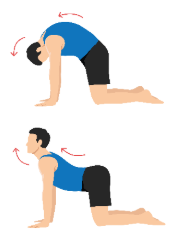
Shoulder Pass-Throughs (Shoulders, Chest)
- How: Use a broomstick or resistance band, hold it wide, and slowly move it overhead and behind your back, then return.
- Reps: 5–8
- Why: Opens up tight shoulders and improves posture. It also feels really good if you’ve been hunched over a desk all day.
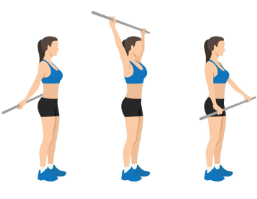
World’s Greatest Stretch (Hips, Spine, Hamstrings)
- How: Start in a lunge, plant one hand inside the front foot, and twist the other arm up toward the sky.
- Reps: 3 per side
- Why: It may not actually be the world’s greatest stretch, but it does hit a ton of mobility zones in one move.
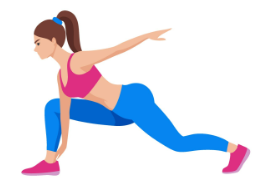
90/90 Hip Rotations (Hips)
- How: Sit on the floor with front and back legs bent at 90 degrees. Rotate legs side to side, switching which leg is in front.
- Reps: 5 per side
- Why: Improves internal and external hip rotation—key for squats, walking, and more.
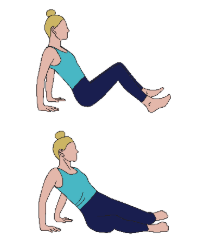
Heel Slides (Knees)
- How: Sit or lie down with legs extended. Slowly slide one heel toward your body by bending the knee, then extend it back out.
- Reps: 10 per side
- Why: Improves knee range of motion—key for walking, balance, all sports and playing with your kids.
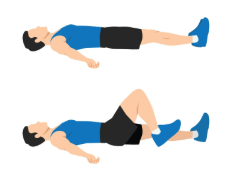
Ankle Circles (Ankles)
- How: Lift one foot and slowly draw circles with your toes to warm up the ankle joint.
- Reps: 10 per side
- Why: Improves ankle range for better balance
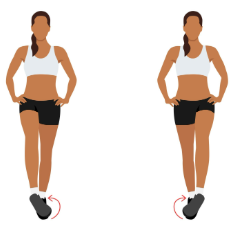
If you have very little time, even just 2–3 of these moves a day (rotated through the week) can help noticeably over time. At risk of overstating the concept… everything feels better with full range of motion.
How Do You Know It’s Working?
- You feel less stiffness or joint pain in everyday movement.
- You can reach or rotate further without compensating.
- You feel more in control of movements, not just bendy.
- You can move deeper into exercises (e.g., lower squat depth with good form).
The Bottom Line on Mobility
Mobility is critical to our daily lives today and as we age. But it is often overlooked in our efforts towards increasing our fitness levels. Without mobility, all the other fitness pillars (flexibility, balance, strength, and endurance) become pretty meaningless. The good news is we can improve and maintain our mobility without much time and effort. Ten minutes a day and a little regular self-adjustment can improve your performance at almost any physical activity and can keep you upright and pain-free well into your nineties. Try some of our basic mobility moves and see if you don’t feel better (and taller) after a week or two.